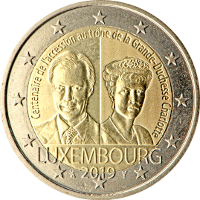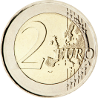 |
C o m m e m o r a t i v e C o i n s |
||
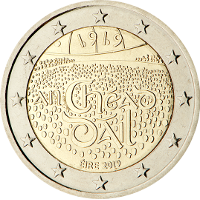 🔎
🔎 |
 |
Ireland | 21 Jan. 2019 | Centenary of the first sitting of Dáil Éireann (House of Assembly) |
20001 20002 20005 |
1,000,000 |  |
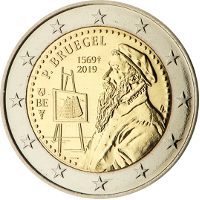 🔎
🔎 |
 |
Belgium | 24 Jan. 2019 | 450th anniversary of the death of Pieter Bruegel the Elder |
20001 20002 20005 |
155,000 |  |
 🔎
🔎 |
 |
Italy | 25 Jan. 2019 | 500th anniversary of Leonardo da Vinci's death |
20001 20002 20005 |
3,000,000 |  |
 🔎
🔎 |
 |
Germany | 29 Jan. 2019 | 70 years of the Bundesrat (Prussian manor house in Berlin) 14th coin in the Federal States series |
20001 20002 20005 |
30,507,300 |  |
 🔎
🔎 |
 |
Spain | 01 Feb. 2019 | Old town of Ávila with its extra‐muros churches 10th coin in the UNESCO World Heritage Sites series |
20001 20002 20005 |
500,000 |  |
 🔎
🔎 |
 |
Andorra | 11 Mar. 2019 | 2019 FIS Alpine Ski World Cup final |
20001 20002 20005 |
60,000 |  |
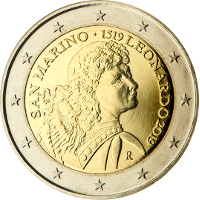 🔎
🔎 |
 |
San Marino | 04 Apr. 2019 | 500th anniversary of Leonardo da Vinci's death |
20001 20002 20005 |
55,650 |  |
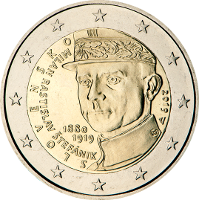 🔎
🔎 |
 |
Slovakia | 25 Apr. 2019 | 100th anniversary of Milan Rastislav Štefánik's death |
20001 20002 20005 |
1,000,000 |  |
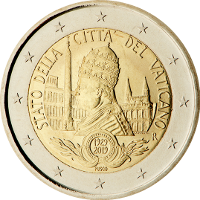 🔎
🔎 |
 |
Vatican City | 07 May 2019 | 90th anniversary of the founding of the Vatican City State |
20001 20002 20005 |
84,000 |  |
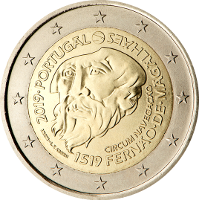 🔎
🔎 |
 |
Portugal | 08 May 2019 | 500th anniversary of Magellan's circumnavigation |
20001 20002 20005 |
520,000 |  |
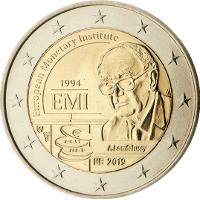 🔎
🔎 |
 |
Belgium | 09 May 2019 | 25th anniversary of the establishment of the European Monetary Institute |
20001 20002 20005 |
155,000 |  |
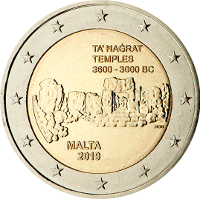 🔎
🔎 |
 |
Malta | 13 May 2019 | Ta' Ħagrat Temples 4th coin of the Maltese Prehistoric Sites series |
20001 20002 20005 |
335,000 |  |
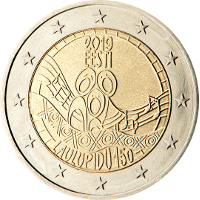 🔎
🔎 |
 |
Estonia | 29 May 2019 | 150th anniversary of the first Estonian Song Festival |
20001 20002 20005 |
1,000,000 |  |
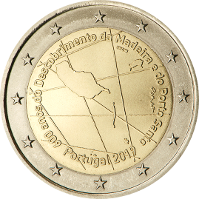 🔎
🔎 |
 |
Portugal | 06 Jun. 2019 | 600th anniversary of the discovery of Madeira and Porto Santos |
20001 20002 20005 |
520,000 |  |
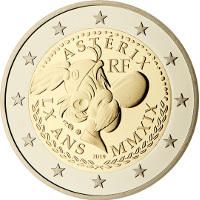 🔎
🔎 |
 |
France | 06 Jun. 2019 | 60th anniversary of the creation of Astérix |
20001 20002 20005 |
310,000 |  |
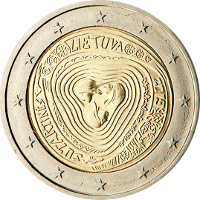 🔎
🔎 |
 |
Lithuania | 10 Jul. 2019 | Sutartinés, lithuanian songs |
20001 20002 20005 |
500,000 |  |
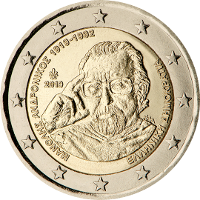 🔎
🔎 |
 |
Greece | 11 Jul. 2019 | 100th birthday of Manolis Andronikos |
20001 20002 20005 |
750,000 |  |
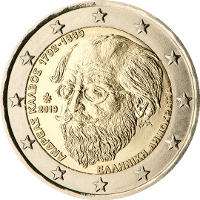 🔎
🔎 |
 |
Greece | 11 Jul. 2019 | 150th anniversary of the death of Andreas Kalvos |
20001 20002 20005 |
750,000 |  |
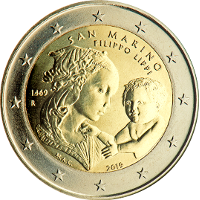 🔎
🔎 |
 |
San Marino | 29 Aug. 2019 | 550th anniversary of Filippo Lippi's death |
20001 20002 20005 |
56,650 |  |
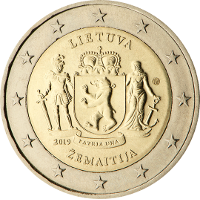 🔎
🔎 |
 |
Lithuania | 10 Sep. 2019 | Žemaitija (Samogitia) 1st coin of the Lithuanian Ethnographical Regions series |
20001 20002 20005 |
500,000 |  |
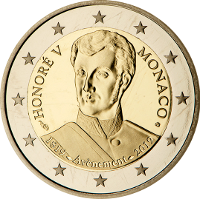 🔎
🔎 |
 |
Monaco | 12 Sep. 2019 | 200th anniversary of Honoré V's accession to the throne |
20001 20002 20005 |
15,000 |  |
 🔎
🔎 |
 |
Latvia | 17 Sep. 2019 | Coat of arms of Latvia's rising sun |
20001 20002 20005 |
307,000 |  |
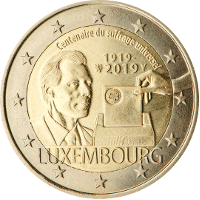 🔎
🔎 |
 |
Luxembourg | 19 Sep. 2019 | 100 years of universal suffrage in Luxembourg 22nd coin of the Grand‐Ducal Dynasty series |
20001 20002 20005 |
311,000 |  |
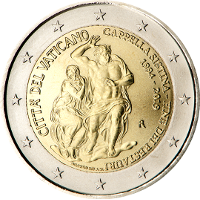 🔎
🔎 |
 |
Vatican City | 07 Oct. 2019 | 25th anniversary of the restoration of the Sistine Chapel |
20001 20002 20005 |
83,000 |  |
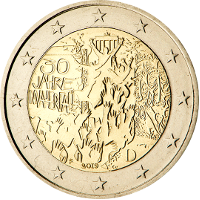 🔎
🔎
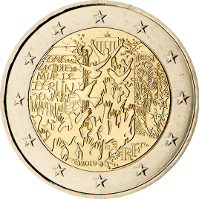 🔎
🔎 |
||||||
 |
Germany | 10 Oct. 2019 | 30th anniversary of the fall of the Berlin Wall Joint issue of Germany and France |
20001 20002 20005 |
30,297,000 |  |
 |
Frankreich |
20001 20002 20005 |
15.020.000 | |||
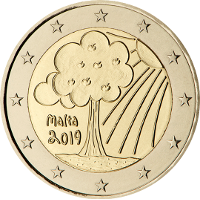 🔎
🔎 |
 |
Malta | 21 Oct. 2019 | Nature and Envirement 4th coin of the from children in solidarity series |
20001 20002 20005 |
320,000 |  |
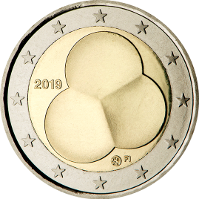 🔎
🔎 |
 |
Finland | 31 Oct. 2019 | Constitution Act of 1919 |
20001 20002 20005 |
500,000 |  |
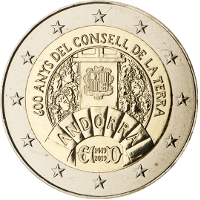 🔎
🔎 |
 |
Andorra | 11 Nov. 2019 | 600th anniversary of the formation of "Consell de la Terra" constitution |
20001 20002 20005 |
60,000 |  |
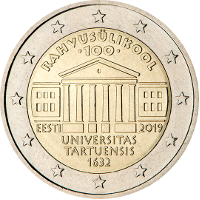 🔎
🔎 |
 |
Estonia | 19 Nov. 2019 | 100 year anniversary of the founding of the Estonian language University Tartu |
20001 20002 20005 |
1,000,000 |  |
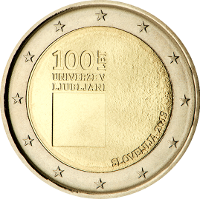 🔎
🔎 |
 |
Slovenia | 25 Nov. 2019 | 100 years since the foundation of the University Ljubljana |
20001 20002 20005 |
1,000,000 |  |
| ⇓ 2020 ⇓ |
| References : | |||
| 20001 | Images taken with authorisation by the ECB ‐ Mail dated 20th of Feb.2020 © "European Central Bank" |
20002 | Data mirrored from Wikipedia Page "2_euro_commemorative_coins" with friendly support of the guardians of that page. |
| 20003 | Not Applicable | 20004 | Coloured version of this Commemorative Coin in circulation EU‐legal‐technical specifications do not recongnise colour prints, but the EU is tolerate them, due to the facts that their numbers are very small and that they are sold in special packs and therefor are very unlikely to be used as currency. |
| 20005 | enlarged Images taken with authorisation by Gerd Seyffert © "Gerd Seyffert 2021" |
20006 | Not Applicable |
 |
